Have Gun - Will Travel
- There are no inadequacies
One of the most popular series of the 50's, featuring the adventures of Paladin, a high-priced, West Point-educated "gun for hire" in the ceaseless battle for law and order in the post-Civil War west.
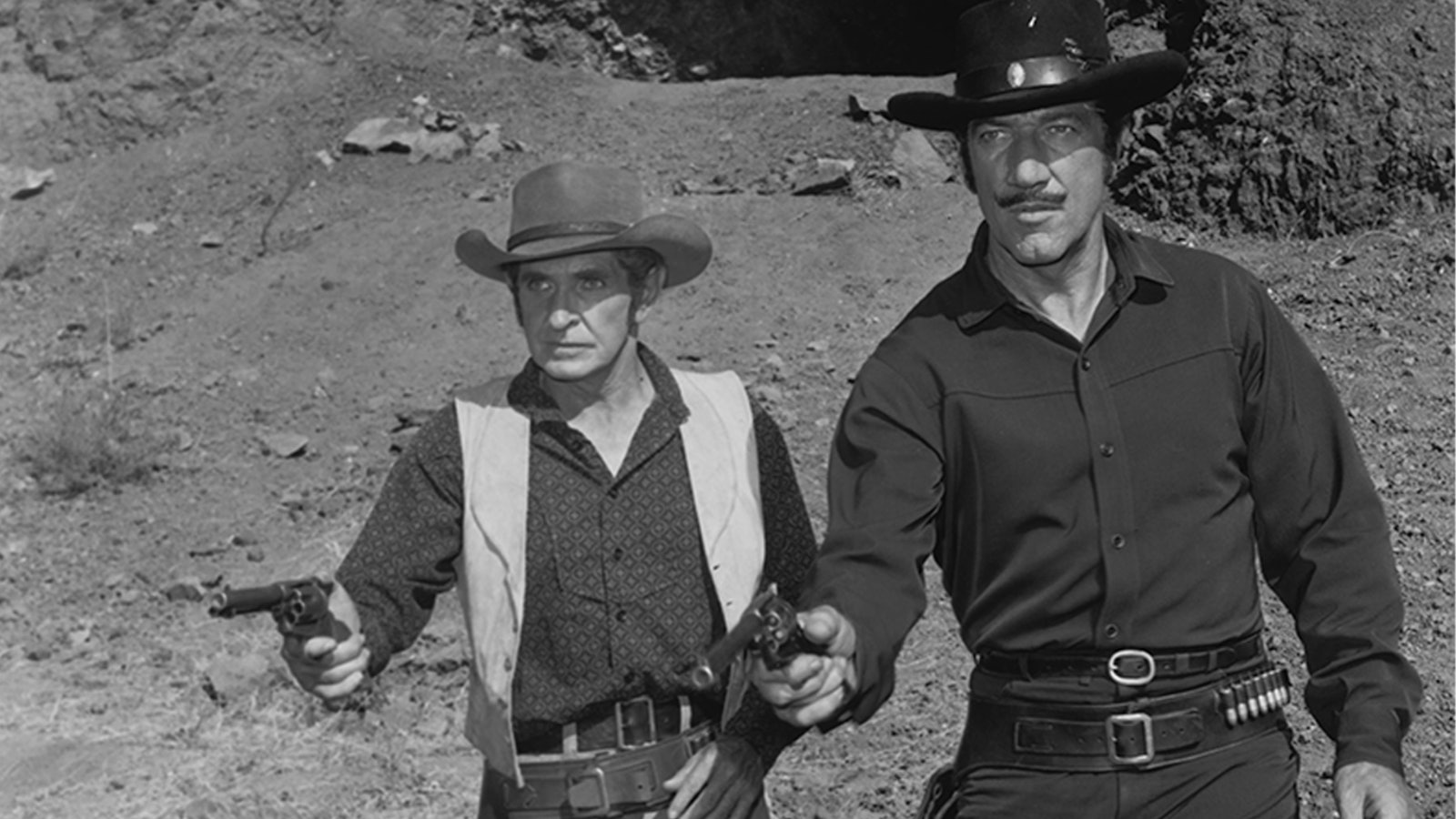
"Have Gun – Will Travel" was a popular American radio and television western series that originally aired in the late 1950s and early 1960s. Created by Sam Rolfe and Herb Meadow, the show followed the adventures of Paladin, a sophisticated and enigmatic freelance gunfighter who lived in San Francisco during the late 19th century. The show centered around Paladin, portrayed by actor John Dehner, who was a well-dressed, highly educated, and cultured gentleman with a strong sense of justice. He lived in the luxurious Hotel Carlton in San Francisco and advertised his services with the calling card that read, "Have Gun – Will Travel." Paladin was known for taking on assignments as a gun for hire, often helping those in need of protection, settling disputes, or seeking justice.Each episode of the radio series presented a self-contained story in which Paladin traveled to various locations, encountering a wide range of characters and situations. While he was a formidable gunfighter, he preferred to use his intelligence and wit to solve problems and conflicts whenever possible, often resorting to violence as a last resort.The show combined elements of traditional Westerns with a more sophisticated and character-driven approach, exploring moral and ethical dilemmas, as well as the complexities of human nature. It also delved into Paladin's own past and personal code of honor, making him a complex and intriguing protagonist."Have Gun – Will Travel" was not only known for its engaging stories but also for its memorable theme music and the distinctive voice of actor John Dehner, who brought Paladin to life with his smooth and commanding delivery.In addition to the radio show, "Have Gun – Will Travel" was later adapted into a successful television series that ran from 1957 to 1963, with Richard Boone portraying Paladin. The character and series remain iconic in the history of American western entertainment, offering a unique blend of action, philosophy, and character-driven storytelling.

Have Gun Will Travel - Old Time Radio Old Time Radio Shows OTR
- DEC 27, 2023
Have Gun Will Travel - Old Time Radio - NoVisitors
- DEC 20, 2023
Have Gun Will Travel - Old Time Radio - Ella West
- DEC 16, 2023
Have Gun Will Travel - Old Time Radio - HangingCross
- NOV 9, 2023
Have Gun Will Travel - Old Time Radio - The Outlaw
- NOV 8, 2023
- NOV 2, 2023
Have Gun Will Travel - Old Time Radio Show - Road To Wickenberg
- © 2023 Quiet. Please
Top Podcasts In Fiction
You might also like.
Jewish Journal
Connect. inform. inspire., 10 traditions seen at jewish weddings.
- By Jamie Mackey
- Published April 18, 2018
Jamie Mackey
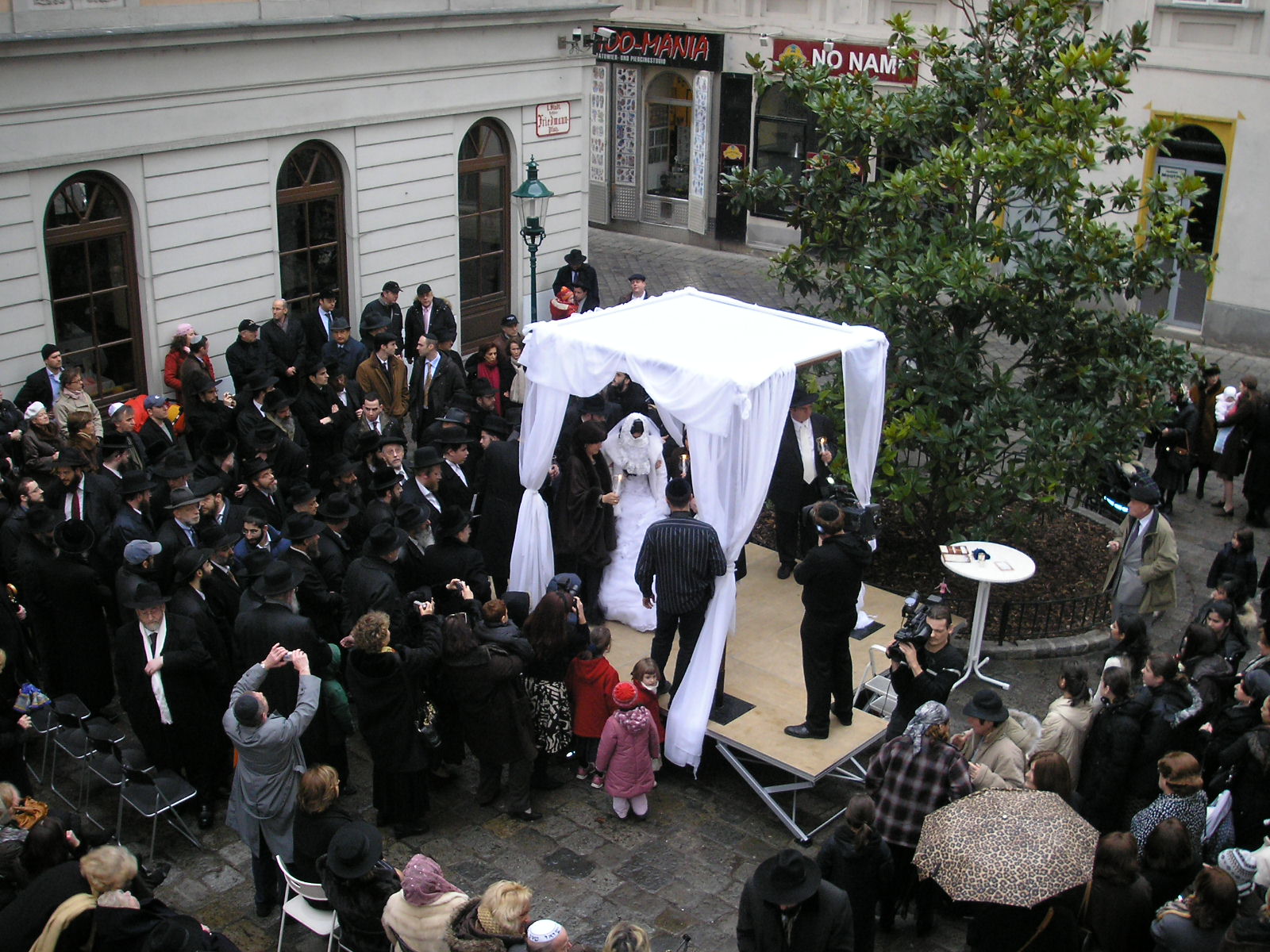
Heading to your first Jewish wedding? Whether it’s Reform or strictly Orthodox, there are Jewish wedding traditions that you definitely will see.
Some may sound familiar, but knowing what to expect (and being versed in the meaning behind what you are watching) will make you even more prepared to celebrate.
10 Jewish wedding traditions:
1. Fasting The wedding day is considered a day of forgiveness. Some couples choose to fast the day of their wedding, just as they would on Yom Kippur. The couple’s fast will last until their first meal together after the wedding ceremony.
2. Bedeken Before the ceremony, the groom approaches the bride for the bedeken, or veiling. He looks at her and then veils her face. This signifies that his love for her is for her inner beauty, and also that the two are distinct individuals even after marriage. It also is a tradition stemming from the Torah, wherein Jacob was tricked into marrying the sister of the woman he loved because the sister was veiled. If the groom does the veiling himself, such trickery can never happen.
3. Ketubah signing The ketubah is a Jewish prenuptial agreement that outlines the groom’s responsibilities to his bride. It dictates the conditions he will provide in the marriage, the bride’s protections and rights, and the framework should the couple choose to divorce. Ketubahs aren’t actually religious documents, but are part of Jewish civil law — so there’s no mention of God blessing the union. The ketubah is signed by the couple and two witnesses before the ceremony takes place, then is read to the guests during the ceremony.
4. The walk to the chuppah Traditionally, both of the groom’s parents walk him down the aisle to the chuppah, the altar beneath which the couple exchanges vows. Then the bride and her parents follow.
5. Vows under the chuppah A chuppah has four corners and a covered roof to symbolize the new home they are building together. In some ceremonies, the four posts of the chuppah are held up by friends or family members, supporting the life the couple is building together. In other instances, it may be a freestanding structure decorated with flowers. The canopy is often made of a tallit, or prayer shawl, belonging to a member of the couple or their families.
6. Circling The bride traditionally circles her groom either three or seven times under the chuppah. Some people believe this is to create a magical wall of protection from evil spirits, temptation and the glances of other women. Others believe the bride is symbolically creating a new family circle.
7. Sheva Brachot: Seven Blessings The Sheva Brachot come from ancient teachings. They often are read in Hebrew and English, and shared by a variety of family members or friends. The blessings focus on joy, celebration and the power of love.
8. Breaking of the glass As the ceremony comes to an end, the groom is invited to step on a glass inside a cloth bag to shatter it. The breaking of the glass holds multiple meanings. Some say it represents the destruction of the Holy Temple. Others say it demonstrates that marriage holds sorrow as well as joy and is a representation of the commitment to stand by each other even in hard times.
9. Mazel tov! Shouting “Mazel tov!” is one of the best-known wedding rituals. After the ceremony is over and the glass is broken, you will hear guests cheer, “Mazel tov!” Mazel tov means “good luck” or “congratulations.”
10. Yichud After the ceremony, tradition dictates that couples spend 18 minutes in yichud (seclusion). This wedding custom allows the newly married couple to reflect privately on their new relationship and allows them precious time alone to bond and rejoice.
Jaimie Mackey’s story appeared at brides.com .
Did you enjoy this article?
You'll love our roundtable., editor's picks.

Israel and the Internet Wars – A Professional Social Media Review

The Invisible Student: A Tale of Homelessness at UCLA and USC

What Ever Happened to the LA Times?

Who Are the Jews On Joe Biden’s Cabinet?

You’re Not a Bad Jewish Mom If Your Kid Wants Santa Claus to Come to Your House

No Labels: The Group Fighting for the Political Center
Latest articles.
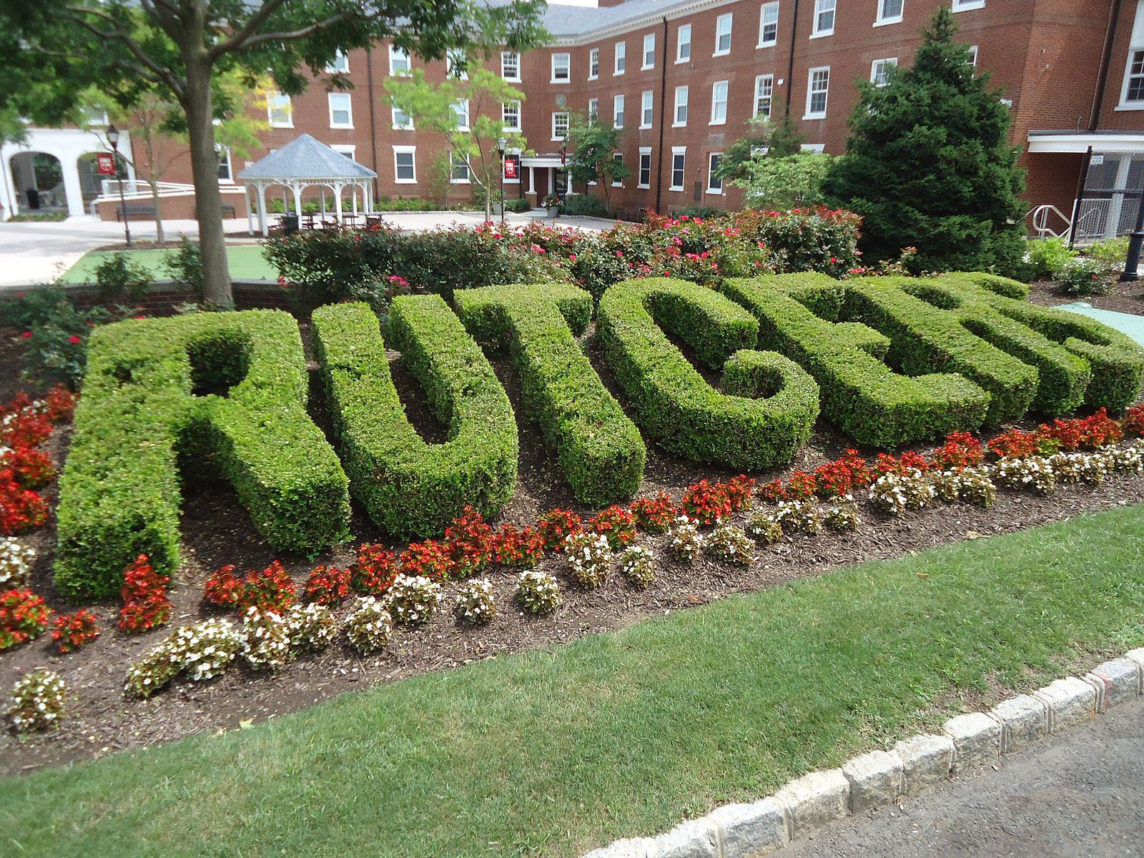
As Student BDS Proposals Proliferate, the Abandonment of Due Process Enables Antisemitism
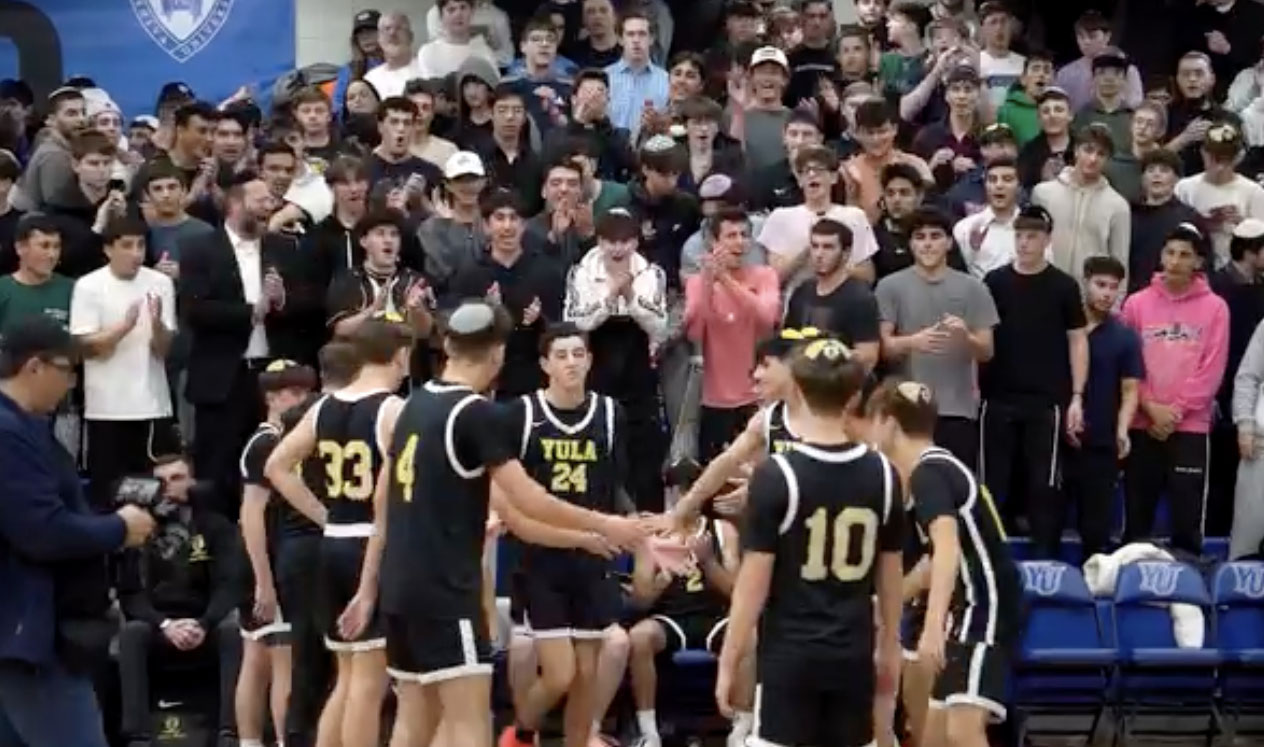
YULA Head of School Reflects on Sarachek Championship
Night of no moon – parshat ha-chodesh 2024.
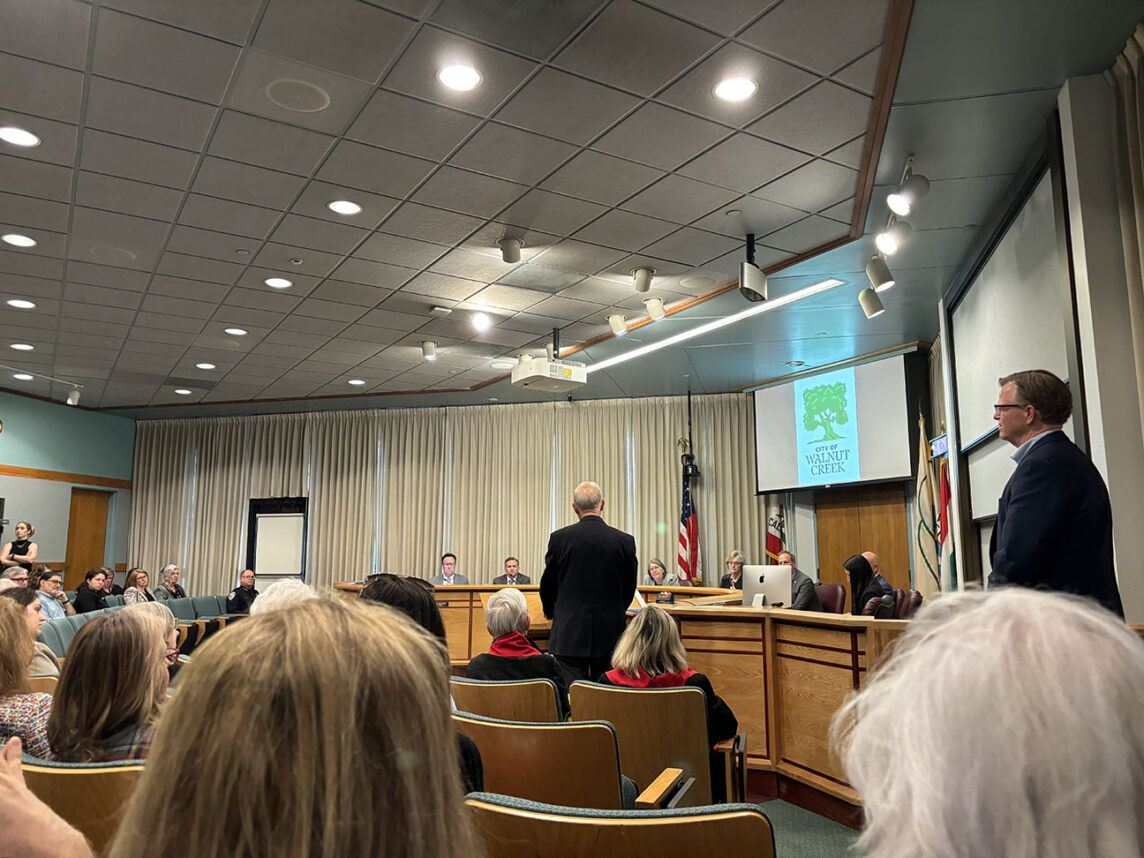
Christian Leaders Denounce Antisemitism at East Bay City Council Meeting
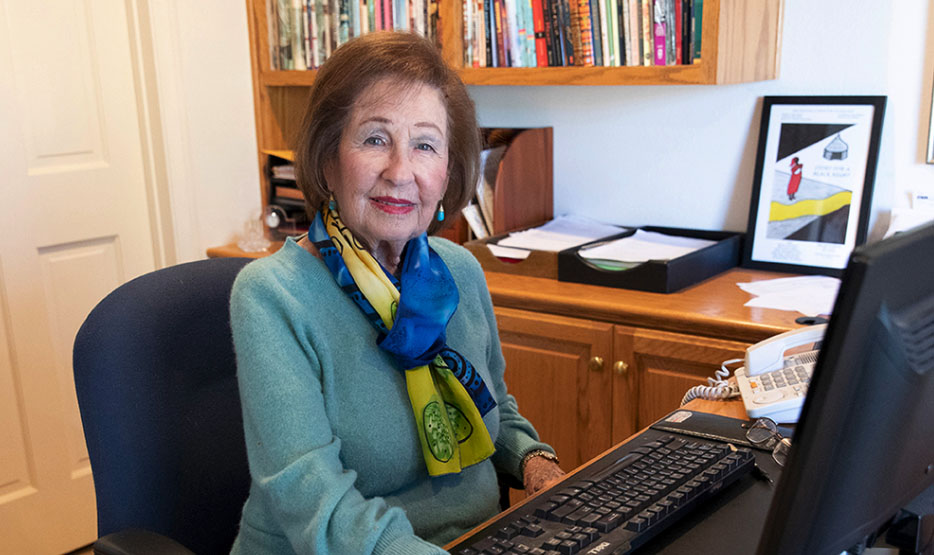
Sonia Levitin: A Holocaust Survivor, Artist, Author, and Playwright of “Chained”
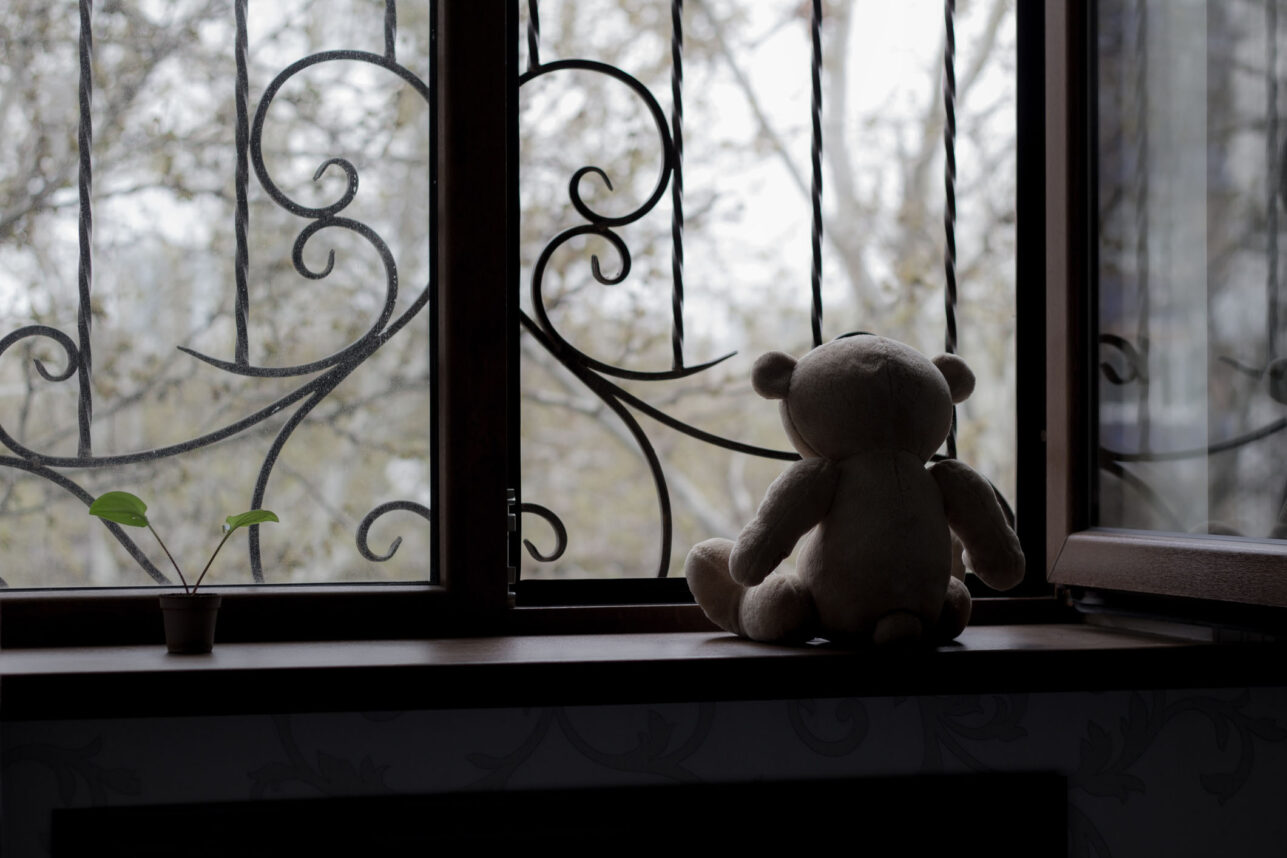
The Death of a Child, The Love for Life
‘cooking for a cause’ cookbook supports leket, sweet silan memories: a juicy roast beef, liz claman: a proud jew at fox business.

Joseph Lieberman’s Legacy: A Courageous Voice for Iranian Democracy
His perspective vis-à-vis the Iranian regime distinguished Lieberman from many of his contemporaries.
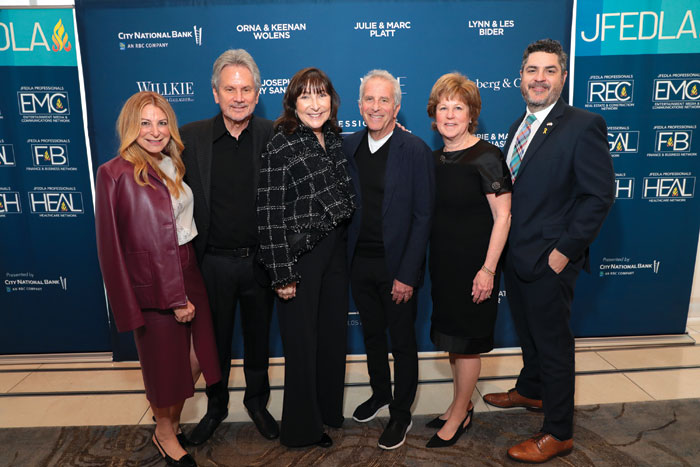
LA Federation Holds Entertainment Event, OC Federation Honors Women Philanthropists, Mensch Foundation Ceremony
Notable people and events in the Jewish LA community.

Complaint: UC Davis Failed to Take Action Against Antisemitism on Campus
Jewish students have been verbally and physically attacked.

The Laws of Creature Eaters – A Poem for Parsha Shemini
I remember what it was like to eat the creatures of the earth.
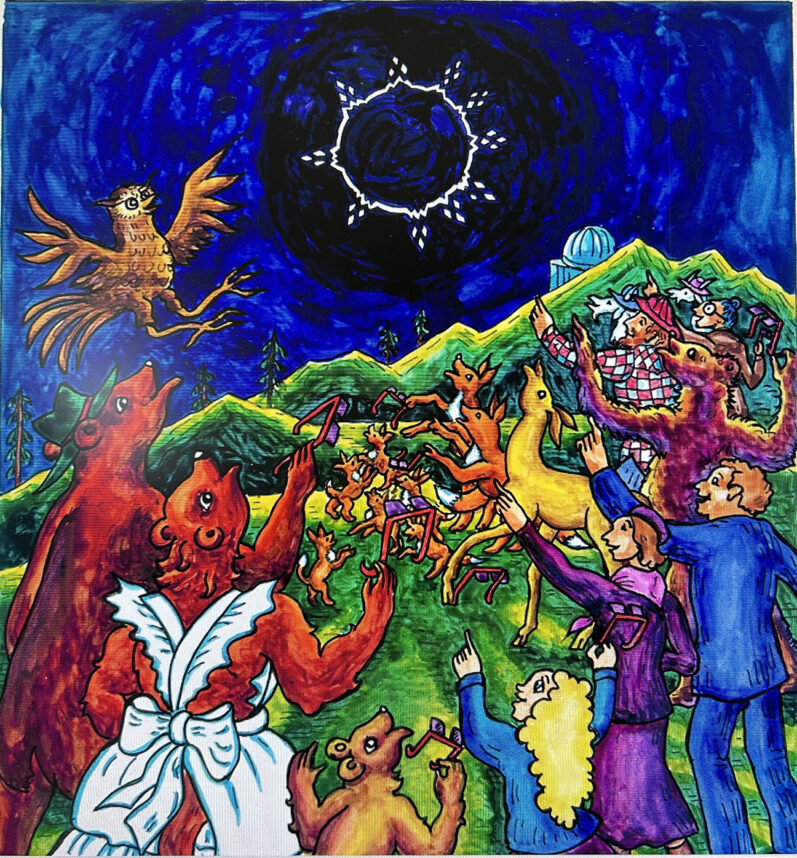
Umbraphiles and Poets Put into the Shade by their Wifely Shidduch

Spielberg Says Antisemitism Is “No Longer Lurking, But Standing Proud” Like 1930s Germany

Young Actress Juju Brener on Her “Hocus Pocus 2” Role

Behind the Scenes of “Jeopardy!” with Mayim Bialik

Joel Haber: 18 Jewish Foods Podcast and Hamin Kharshuf aka Chulent
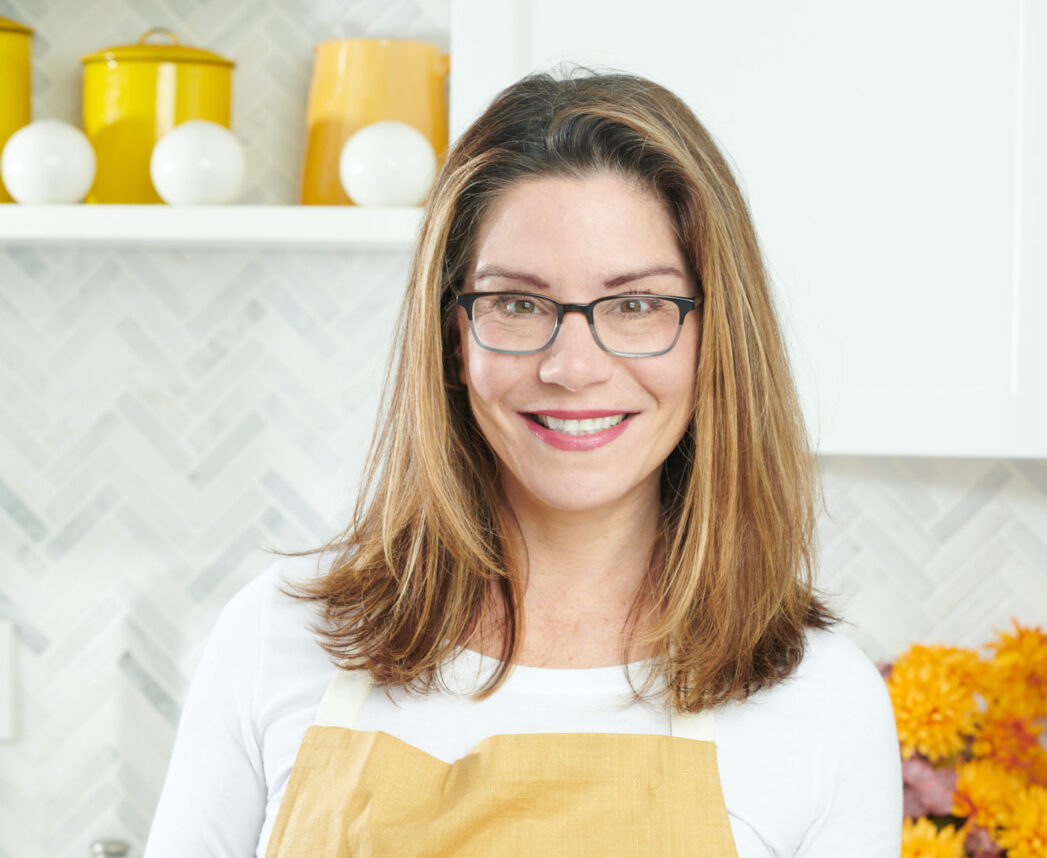
Katie Workman: The Mom 100, Comfort Food and Ground Turkey Tacos
More news and opinions than at a shabbat dinner, right in your inbox..
Get JTA's Daily Briefing in your inbox
I accept the JTA Privacy Policy .
By submitting the above I agree to the privacy policy and terms of use of JTA.org
A shotgun (literally) Jewish wedding and two lawsuits
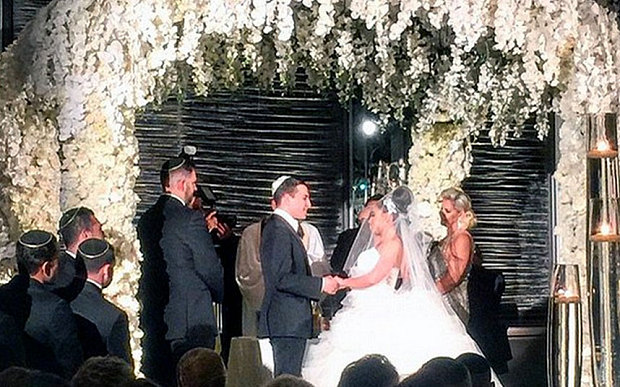
It’s a story that highlights two unique, and frequently maligned, aspects of American culture: easy access to guns and a zeal for lawsuits.
And at its center is a Jewish wedding.
Anna Goldshmidt and Elan Stratiyevsky are suing Stratiyevsky’s cousin Vladimir Gotlibovsky for ruining their June wedding at the Waldorf Astoria by accidentally firing his pistol at the swanky pre-ceremony cocktail reception and grazing the head of a guest.
Not to be outdone, Gotlibovsky, 42, is himself suing the upscale Manhattan hotel for canceling (unnecessarily, he says) the post-ceremony reception.
In canceling the reception, the hotel said it feared for the safety of the guests.

The exterior of the Waldorf-Astoria Hotel in New York is shown, March 14, 1999. (Stephen Chernin, AP Images)
According to the U.K. Telegraph , Gotlibovsky, who owns a Bronx liquor store, argues that the Waldorf should pay at least half of whatever the court says he must pay the couple.
“He was not responsible for the cancellation of the wedding reception,” his attorney, Christopher Chang, said, adding, “The fact of the matter is after the firearm discharged, the hotel was secure and the reception could have gone forward.”
Gotlibovsky, 42, legally carried the gun and has not been charged with any crime.
The bullet tore a hole in Gotlibovsky’s pants and ricocheted off the marble floor. After the gun was fired, Gotlibovsky gave it to his brother, who took it out of the hotel.
Gotlibovsky also mistakenly fired his gun in December 2014, when he accidentally shot himself in the foot, according to The Telegraph.
“Her dream wedding was cancelled and can never be recaptured,” the lawsuit against Gotlibovsky said. “There will never be a wedding album; what was to be the happiest day of her life turned into a disaster.”
Share this:
Recommended from jta.
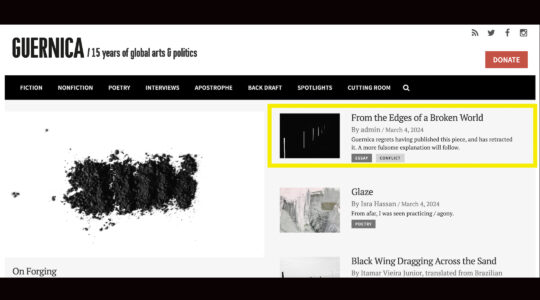
Guernica editor who published Israeli writer’s coexistence essay resigns, saying she disagreed with retraction
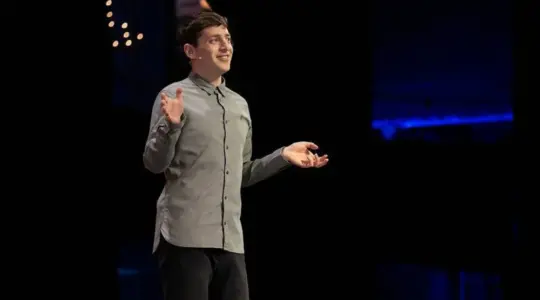
Alex Edelman’s ‘Just For Us’ premieres on HBO and Max, with Jewish identity and antisemitism again in the spotlight
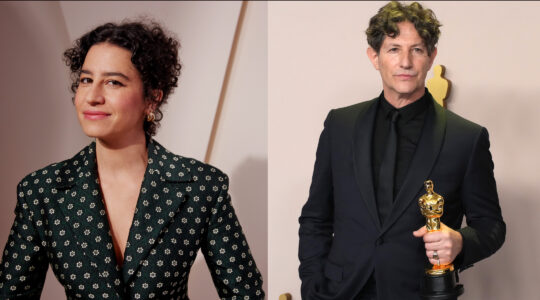
Elliot Gould, Joaquin Phoenix, Ilana Glazer, 150+ Jewish creatives sign open letter backing Jonathan Glazer’s Oscars speech
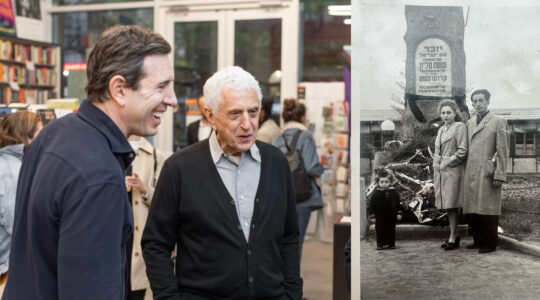

On the Lower East Side, a corporate ‘fixer’ honors his Jewish roots with a unique, NYC-centric bookstore
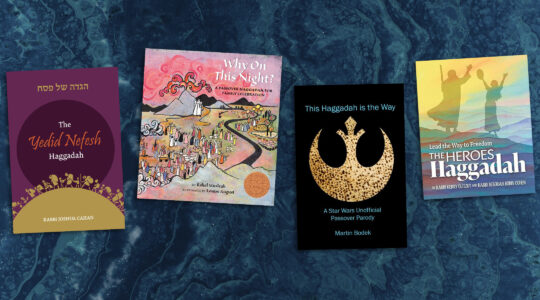
Inside 10 new haggadahs for 2024: America and Israel take their places at the seder table
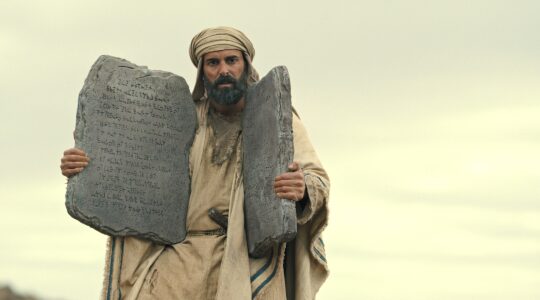
‘Testament: The Story of Moses’ is one of Netflix’s top shows — and it features multiple rabbis
90 years of expert advice and inspiration, for every couple.
- Engagement Rings
- Wedding Bands
- Celebrity Weddings & News
- Wedding Planning
- Destination Wedding
- Invitations & Stationery
- Wedding Décor
- Flowers & Bouquets
- Food & Drink
- Wedding Cakes
- Photography
- Wedding Dresses
- Bridesmaid Dresses
- Makeup & Hair
- Accessories
- Groom Style
- Wedding Party Attire
- Wedding Guest Attire
- Bridal Fashion Week
- Skincare & Wellness
- Engagement Party
- Bridal Shower
- Bachelorette Party
- Rehearsal Dinner
- Registry Tips
- Anniversary Gifts
- Wedding Favors
- Friends & Family
- Marriage Proposal Ideas
- Married Life
- Love & Dating
- The Brides Team
- Editorial Guidelines
- Editorial Policy
- Terms of Use and Policies
- Privacy Policy
- Wedding Ideas & Advice
- Wedding Ceremony Ideas
13 Jewish Wedding Traditions and Rituals
We consulted a Rabbi.
Jaimie Mackey was the real weddings editor at Brides from 2013 to 2015. She also worked as a luxury wedding planner and produced over 100 high-end weddings and events in Colorado
Photo by VICKI GRAFTON PHOTOGRAPHY
Heading to your first Jewish wedding? Whether it's Reform or strictly Orthodox, there are some Jewish wedding traditions that you will definitely see. Some may sound familiar , but knowing what to expect (and being versed in the meaning behind what you're watching) will make you even more prepared to celebrate.
"A Jewish wedding ceremony is a little bit fluid, but there is a basic outline," says Rabbi Stacy Bergman . "The ceremony can also be personalized by having the officiant really speak to the couple and tell their story."
Meet the Expert
Rabbi Stacy Bergman is an independent rabbi in New York. She received her Rabbinic Ordination and a Master's Degree in Hebrew Letters at Hebrew Union College.
Read on for the most common traditions you'll see at a Jewish wedding.
Aufruf is a Yiddish term that means "to call up." Prior to the wedding ceremony, the bride and groom are called to the Torah for a blessing called an aliyah . After the aliyah , the rabbi will offer a blessing called misheberach , and at that time it is customary for members of the congregation to throw candies at the couple to wish them a sweet life together.
The wedding day is considered a day of forgiveness, and as such, some couples choose to fast the day of their wedding, just as they would on Yom Kippur (the Day of Atonement). The couple's fast will last until their first meal together after the wedding ceremony.
Ketubah Signing
The ketubah is a symbolic Jewish marriage contract that outlines the groom's responsibilities to his bride. It dictates the conditions he will provide in the marriage, the bride's protections and rights, and the framework should the couple choose to divorce. Ketubahs aren't actually religious documents, but are part of Jewish civil law—so there's no mention of God blessing the union. The ketubah is signed by the couple and two witnesses before the ceremony takes place, then is read to the guests during the ceremony.
During the ketubah signing, the groom approaches the bride for the bedeken , or veiling. He looks at her and then veils her face. This signifies that his love for her is for her inner beauty, and also that the two are distinct individuals even after marriage. It also is a tradition stemming from the Bible wherein Jacob was tricked into marrying the sister of the woman he loved because the sister was veiled. If the groom does the veiling himself, such trickery can never happen.
The Walk to the Chuppah
In Jewish ceremonies, the processional and recessional order is slightly different than traditional non-Jewish ceremonies. In the Jewish tradition, both of the groom's parents walk him down the aisle to the chuppah , the altar beneath which the couple exchanges vows. Then the bride and her parents follow. Traditionally, both sets of parents stand under the chuppah during the ceremony, alongside the bride, groom, and rabbi.
Vows Under the Chuppah
A chuppah has four corners and a covered roof to symbolize the new home the bride and groom are building together. In some ceremonies, the four posts of the chuppah are held up by friends or family members throughout the ceremony, supporting the life the couple is building together, while in other instances it may be a freestanding structure decorated with flowers . The canopy is often made of a tallit , or prayer shawl, belonging to a member of the couple or their families.
In the Ashkenazi tradition, the bride traditionally circles around her groom either three or seven times under the chuppah. Some people believe this is to create a magical wall of protection from evil spirits, temptation, and the glances of other women. Others believe the bride is symbolically creating a new family circle.
Ring Exchange
Traditionally, Jewish brides get married in a wedding band that is made of metal (gold, silver, or platinum ) with no stones. In ancient times, the ring was considered the object of value or “purchase price” of the bride. The only way they could determine the value of the ring was through weight, which would be altered should there be stones in the ring. In some traditions, the rings are placed on the left forefinger because the vein from your forefinger goes right to your heart.
Sheva B'rachot: Seven Blessings
The seven blessings called the Sheva B'rachot come from ancient teachings. They are often read in both Hebrew and English and shared by a variety of family members or friends, just as friends and family are invited to perform readings in other types of ceremonies. The blessings focus on joy, celebration, and the power of love. They begin with the blessing over a cup of wine , then progress to more grand and celebratory statements, ending with a blessing of joy, peace, companionship, and the opportunity for the bride and groom to rejoice together.
Breaking of the Glass
As the ceremony comes to an end, the groom (or in some instances the bride and groom) is invited to step on a glass inside a cloth bag to shatter it. The breaking of the glass holds multiple meanings. Some say it represents the destruction of the Temple in Jerusalem . Others say it demonstrates that marriage holds sorrow as well as joy and is a representation of the commitment to stand by one another even in hard times. The cloth holding the shards of glass is collected after the ceremony, and many couples choose to have it incorporated into some sort of memento of their wedding day.
Shouting " Mazel tov! " is one of the most well-known Jewish wedding rituals. Once the ceremony is over and the glass is broken, you will hear guests cheer "Mazel tov!" Mazel tov has a similar meaning "good luck" or "congratulations." The direct translation is actually closer to wishing the best for the future, a great destiny, or a pronouncement that the person or people have just experienced great fortune. There's no better time to say "mazel tov" than at a wedding!
Following the ceremony, tradition dictates that couples spend at least eight minutes in yichud (or seclusion). This wedding custom allows the newly married couple to reflect privately on their new relationship and allows them precious time alone to bond and rejoice. It's also customary for the bride and groom to share their first meal together as husband and wife during the yichud. Customary meals differ from community to community and can range from the "golden soup" of the Ashkenazim (said to indicate prosperity and build strength) to chocolate chip cookies from grandma.
Hora and Mezinke
The celebratory dance at the reception is called the hora where guests dance in a circle. Oftentimes, you will see women dancing with women and men dancing with men. The bride and groom are seated on chairs and lifted into the air while holding onto a handkerchief or cloth napkin. There is also a dance called the mezinke , which is a special dance for the parents of the bride or groom when their last child is wed.
Related Stories
The Ultimate Guide to the Wedding Processional Order
10 Israeli Wedding Traditions
The Ultimate Wedding Ceremony Outline
This Couple Threw a Microwedding in Brooklyn Before Hosting a Multi-Day Event in Florence
10 Persian Wedding Traditions
17 Traditional Wedding Vows to Inspire Your Own
8 Sample Wedding Ceremony Scripts To Borrow for Your 2022 Wedding
A Korean-Jewish Wedding With a Surprise Drag Show in San Francisco
An Autumnal 12-Person Backyard Wedding in Pennsylvania
10 Common Wedding-Related Events and Parties to Know About
72 Sweet LGBTQ+ Wedding Photos from Real Couples
A Brides Editor’s Spring Wedding on Long Island
A Virginia Farm Wedding With Tarot Cards, Peacocks, and a Bold Color Palette
A Glossary of Wedding Words and Terminology from A to Z
A Beloved Paris Restaurant Was the Inspiration Behind This Colorful Wedding in Washington, D.C.
Sheva Brachot (7 Blessings): Everything You Need to Know About This Jewish Wedding Tradition
Trending Topics:
- Say Kaddish Daily
- Passover 2024
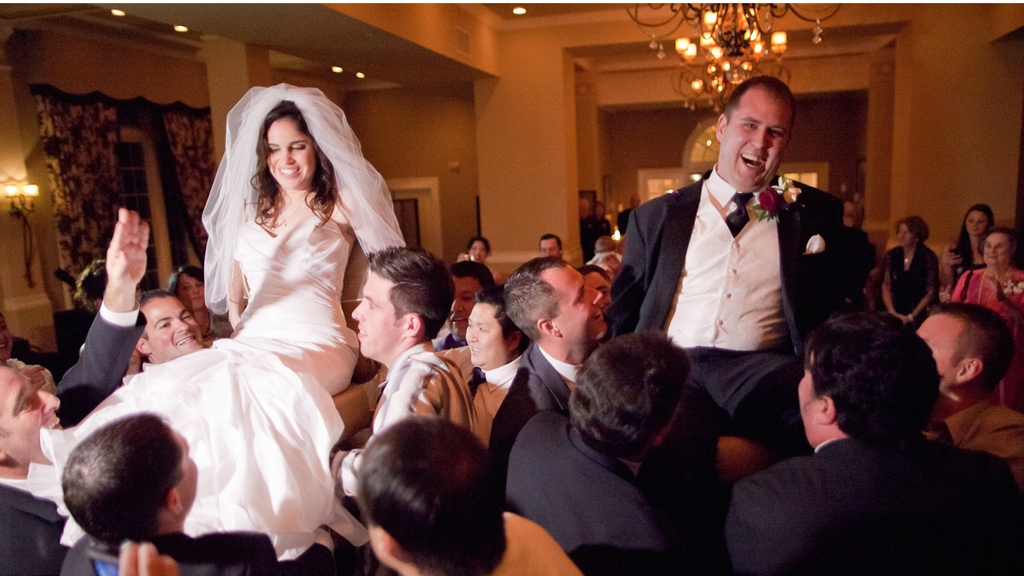
How to Plan a Jewish Wedding
A checklist of 7 things to consider, from clergy to chuppah.
By Gabrielle Kaplan-Mayer
Are you planning a Jewish wedding? Let us help out! Sign up for Breaking the Glass, an email series that will help guide you to the wedding that’s right for you!
1. Choosing a Date

Jewish weddings are traditionally prohibited on Shabbat and most holidays — including Rosh Hashanah, Yom Kippur, Passover, Shavuot, and Sukkot — and the fast days Tisha B’Av, the 10th of Tevet, the 17th of Tammuz, the Fast of Gedaliah, and the Fast of Esther. Traditionally, Jewish weddings are not held during the counting of the omer between Passover and Shavuot, although customs differ as to whether that entire seven-week stretch or just part of it is a problem. Marrying during the three weeks between the 17th of Tammuz and Tisha B’Av is also prohibited in traditional Jewish practice. Because many of these dates fall during prime wedding season (spring-summer), it’s important to check a Jewish calendar before you select a date.
And although Shabbat weddings are out, many couples choose to wed on Saturday at sundown, so that they can begin their ceremony with havdalah , marking both the end of Shabbat and the end of the time that came before their public commitment to one another. Some couples choose to wed on Tuesdays, believing it to be an especially blessed day, since in the Biblical story of creation, the phrase “God saw that it was good” appears twice on the third day.
2. Selecting an Officiant

For some couples, this step is an easy one. They may be active members of a congregation or have a childhood or Hillel (college) rabbi that they are still close to. But for many engaged couples who are not affiliated with a Jewish community in a formal way, finding a rabbi or cantor to lead their wedding ceremony is a daunting task. Parents may suggest using the rabbi from their congregation, whether or not the couple knows them.
First off, it’s important to know that a rabbi is not the only person who can lead a Jewish wedding. A cantor can officiate, as can another educated professional serving the Jewish community. Increasingly, couples are asking friends to officiate by becoming ordained as a Universal Life Minister . To meet most states’ requirements, the officiant does need to be a recognized member of the clergy; be sure to ask this question of any clergy you speak with.
You may want to begin the search for your rabbi by visiting local congregations and observing how different rabbis lead services. You can also contact rabbinical schools to connect with a student rabbi, whose work will be supervised by an experienced faculty member. Students are eager to gain experience and may even give you more time than a busy congregational rabbi could.
Rabbis’ schedules fill up quickly, so if you have a particular rabbi in mind, be sure to clear the date with him or her as soon as possible. Interfaith couples who encounter difficulties finding a rabbi can contact Interfaithfamily.com ( Officiation Request Form ), or the Rabbinic Center for Research and Counseling ( www.rcrconline.org ), which work with interfaith couples and can help them to find a rabbi.
When you meet with rabbis you are considering, be sure to ask them their philosophy about leading weddings, if they are open to adapting rituals, and what kind of ketubah [marriage contract] text they prefer that couples use. You want to make sure that you are on the same page about major issues from the start.
3. Planning the Ceremony
Even couples who grew up in a Jewish home with years of Jewish education may find themselves surprised when it comes to examining traditional Jewish wedding rituals. For example, in a traditional ceremony, only the groom gives the bride a ring, an act which is thought to symbolize kinyan (acquisition).
Many contemporary egalitarian couples find this ritual to be not in keeping with their values and choose to do a double-ring ceremony; some Orthodox rabbis will allow a modified form of this. While working with a rabbi can help you learn about the wedding rituals, you will probably get more out of the experience by doing a bit of research, so you can bring ideas to your meetings with the rabbi. (See Recommended Reading .)
4. Choosing a Ketubah

Just as our government issues a marriage license, Jewish law has historically used a ketubah to sanction a marriage. Ketubah means “writing” or “written” and refers to the document that is signed by witnesses before and often read during a Jewish wedding. Traditionally, a ketubah served as a kind of premarital contract, outlining a bride’s ongoing rights: food, clothing, and even sex should be provided during the course of the marriage. The ketubah also specified her rights in the case of her husband’s death or their divorce.
Many contemporary couples choose to veer away from the traditional ketubah text and its implications and instead choose a text that expresses their hopes and commitments for their marriage. Some couples write their own text, while others search for a text that speaks to their vision.
Historically, the ketubah is not only a legal document, but also an artistic one. Ketubot [plural of ketubah] have long been–and continue to be–an expression of Jewish creativity. So couples not only have decisions to make about the text, but also the kind of art they want for their ketubah. Some couples shop together for a lithograph; others hire an artist to create an original design.
Couples should also think about who they want to invite to sign their ketubah. Traditionally, a witness must be a religiously observant Jewish male, unrelated to the bride or groom. Reform and Reconstructionist and some Conservative rabbis accept women as witnesses, though most still prefer that the witness be Jewish.
5. Selecting a Chuppah

The chuppah is the canopy that covers the bride and groom during the wedding ceremony, creating a sacred space that is both open for all to see and private and intimate for the couple beneath it. It symbolizes their new home together, and is said to be open as was the tent of Abraham and Sarah, who were always ready to receive visitors.
In planning your wedding, think about what kind of chuppah would be special for you. Some are covered in flowers, others are made of fabric squares that friends and family decorate for the couple. The chuppah is attached to four poles, which can be free-standing or held by four people. It is considered a great honor to hold a chuppah pole, so this job should be given to people very close to the bride or groom.
6. Including Ritual Objects

Jewish weddings call for some objects that, with a little thought, can be enhanced to create special meaning for your wedding. For example, at most Jewish weddings kippot ( yarmulkes ) are provided for guests. Many couples have them imprinted with their name and wedding date; others knit original kippot or paint or decorate satin or felt ones to match wedding decor. Couples also need a kiddush cup for under the huppah, and some couples are creating a new tradition by using one heirloom cup from each family. And no Jewish wedding is complete without the glass for breaking at the end of the ceremony. Today’s couples are sometimes saving the pieces of their broken glass to be transformed into a new piece of Judaica, such as a mezuzah or candlesticks.
7. Making Pre-wedding Choices
One of the greatest things about Jewish weddings is that the celebration is spread out over time, giving you maximum time to honor bride and groom. The celebration may begin with an aufruf , when bride and groom (in traditional circles, only groom) are called to the Torah for an aliyah . They receive a mi shebeirakh blessing, which invokes God’s blessing for the bride and groom, and then they are showered with candy, a symbol of sweetness to come in their life together. Many couples host a kiddush lunch following services. This can be an ideal time to include the entire community in your wedding joy.
You and your partner should also discuss whether you want to include various traditional pre-wedding rituals such as going to the mikvah (ritual bath), separating from one another during the week before your wedding, and fasting on your wedding day. These rituals can help the couple prepare spiritually for the seriousness of the day to come. While a Jewish wedding is full of joy, it is also like a personal Yom Kippur for the bride and groom, who want to enter their marriage with a pure heart. Many couples choose to follow an altered version of some of these traditions, such as eating something light before the ceremony to protect against fainting.
You and your partner should give yourselves ample time to talk through each of these seven steps, and to use the process of planning your wedding as an opportunity to learn more about Jewish tradition and the way each of you envisions your life together once you step out from under the chuppah, hand in hand.
Pronounced: KHOOP-uh or khoo-PAH, Origin: Hebrew, canopy under which a Jewish wedding ceremony takes place.
Pronounced: kuh-TOO-buh, Origin: Hebrew, the Jewish wedding contract.
Pronounced: shuh-BAHT or shah-BAHT, Origin: Hebrew, the Sabbath, from sundown Friday to sundown Saturday.
Pronounced: sue-KOTE, or SOOH-kuss (oo as in book), Origin: Hebrew, a harvest festival in which Jews eat inside temporary huts, falls in the Jewish month of Tishrei, which usually coincides with September or October.
Pronounced: tah-MOOZ (oo as in boot), Origin: Hebrew, Jewish month that usually coincides with June or July.
Pronunced: TORE-uh, Origin: Hebrew, the Five Books of Moses.
Pronounced: yohm KIPP-er, also yohm kee-PORE, Origin: Hebrew, The Day of Atonement, the holiest day on the Jewish calendar and, with Rosh Hashanah, one of the High Holidays.
Join Our Newsletter
Empower your Jewish discovery, daily
Discover More
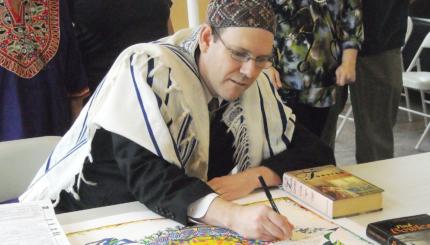
Weddings & Marriage
How to Choose a Ketubah, or Jewish Marriage Contract
A guide to finding the right document for your wedding.
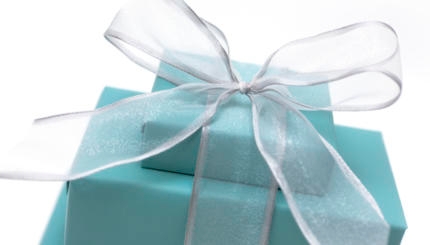
What Gift Do You Give at a Jewish Wedding?
My Jewish Learning's official wedding gift guide.

Being a Guest at a Jewish Wedding: A Guide
From chuppah to glass-breaking, here's what to expect at Jewish nuptials.
Notice to Our Readers
Putting the blame for a barn fire on Opie Taylor in
“The Andy Griffith Show”.
- Copy article link
In "Don't Eat the Daisies."
“Guestward Ho!” with character actor J. Carroll Naish, center.
In "Have Gun Will Travel."
As Judy Carne’s nemesis on “Fair Exchange.”
In “The Journey” starring Yul Brynner and Deborah Kerr, and playing Goldberg’s younger brother was Ron Howard.
With Eleanor Roosevelt in the radio station.
Hanging out with Roger Maris, left, and Mickey Mantle.
With Yul Brynner in “The Journey.”
Valley man looks back on childhood career as Flip Mark
- SALVATORE CAPUTO | Assistant Managing Editor
- Dec 11, 2013
T he agent was on the phone with a photographer offering some modeling work for a red-haired, freckle-faced boy. Philip Goldberg, who had just walked into the office for the first time with his mother, filled the bill exactly. The agent covered the phone receiver and asked his mother, “What’s his name?”
“Philip Goldberg,” his mom said.
“That won’t work,” the agent said. “Does he have a nickname?” “Flip.”
“That’s good. Does he have a middle name?” “Mark.”
The agent uncovered the receiver and said, “His name is Flip Mark.”
“That’s literally how I got the name. It was that fast,” Goldberg, who turns 65 on Dec. 22, says today.
That happened when he was about 7 years old and led to a career as a print advertising model and child actor on stage, screen and television. His last acting gig, he says, was in a “Streets of San Francisco” episode in 1972, a police series that starred Karl Malden and Michael Douglas. Along the way, he worked with Jackie Gleason, Yul Brynner, Doris Day, Dean Martin and many others. He counts among his friends and acquaintances people like Stanley Livingston of “My Three Sons” and Jon Provost of “Lassie,” who like Goldberg, were then child actors.
What brought him to the agent’s office that day in the 1950s? His parents used to send out holiday cards that included his picture, and the boss of his cousin’s ex-wife saw the freckled face, and said, “Oh, he looks like the typical American boy. Would his parents let him do commercial modeling?” Goldberg’s mother, who had done some acting, was intrigued, and his father wasn’t against it, but said he wasn’t going to pay for any pictures.
Goldberg’s dad needn’t have even thought about it. It turned out that the young boy took direction well and got that very first job in a print advertisement and never looked back. He appeared in ads for everything from Kellogg’s cereals to Ohrbach’s, a New York-based department store chain.
Being based in New York, there was a good deal of work available. “I did that for a number of years, interspersed with television commercials,” he says. “At that time, almost everything [on TV] was live in New York. ... And that eventually led into some actual parts, where I was doing some TV shows and eventually a Broadway show and eventually a movie.”
The Broadway show was a revival of “Annie Get Your Gun” that was quickly followed by a trip to Europe to film the movie, “The Journey.” In the film, he was among a group of Western travelers trying to leave Hungary during the 1956 Soviet invasion. It was a big Hollywood Cold War story starring Yul Brynner and Deborah Kerr, and playing Goldberg’s younger brother was Ron Howard, years away from becoming the Opie of the masses in Mayberry.
When they returned from that project, his agent, who had an office in California, told them that the boy needed to go to California because there would be so much work.
They decided to go out on a family vacation and visit Disneyland. When his father went back to New York, Goldberg and his mother stayed behind for another month so that he could play George, one of the children of Doris Day and David Niven in “Please Don’t Eat the Daisies.” Among Goldberg’s siblings was Stanley Livingston, or Chip to those who remember “My Three Sons.” Goldberg is immortalized in the film’s poster, wearing an Indian headdress and pulling back on a bowstring.
A role in a sketch opposite comedian Shelley Berman in the 1960 Emmy-winning TV special, “The Fabulous Fifties” was a turning point.
“After that show, I had offers for six TV series,” Goldberg says. “I was a hot commodity and was interviewed by a newspaper in New York and the interview was done at Sardi’s. Suddenly, someone yells out, ‘You, kid.’ We looked and it was Jackie Gleason, and he said, ‘You were terrific [on ‘The Fabulous Fifties’].’” Gleason didn’t recall that he’d worked with Flip Mark several years earlier.
Before he was offered a TV series, Goldberg’s parents were content with the nation-spanning commute from work in New York to Hollywood as the boy pursued advertising, stage and film jobs, but that would be impractical if he took a role in a weekly series.
His father told him, “If this is really what you want to do, we’ll sell the house in New York ... and we’ll just move out there.” And that’s what they did.
“Guestward Ho,” about a New York family that moved out West to open up a dude ranch, was his first TV series. The Desi Arnaz-produced show, which ran in 1960-61, starred character actor J. Carroll Naish.
His second series was “Fair Exchange,” about a pair of World War II buddies – one British, one American – who decide to exchange their teenage daughters across the pond for a year. Goldberg played Larry Walker, son of Eddie Foy Jr., who got into mischief with the exchanged British daughter, played by the young Judy Carne, well before “sock it to me” became part of the vernacular.
All the while, he worked in other films including “Safe at Home,” which united the young sports fan with baseball greats Roger Maris and Mickey Mantle, and on TV series ranging from “The Outer Limits” to the Western “Have Gun – Will Travel” to “The Andy Griffith Show” to “My Favorite Martian.” (He continued working till he went to college, even learning to ride a motorcycle in Dean Martin’s driveway for his role in “Marriage on the Rocks.”)
He continued commuting from coast-to-coast because there was still a good deal of commercial work for him in New York, working with “Mr. Wizard” (Don Herbert) and General Electric.
“It was an exciting time,” Goldberg says. “In L.A., my mom came with me to the studio whenever I was working, and my dad did various things. I was contributing to the household, and my dad made some real sacrifices for me to pursue that.” And that meant some challenges. “It was a different world then, the money wasn’t what it is now,” he says, but over all recalls his parents’ role in his unusual upbringing with fondness.
“They were unique among parents of child actors,” he says. “Most directors and producers wanted nothing to do with stage parents: ‘We want to have a child in this movie or TV show. It’s just too bad we have to put up with the parents.’ ... My parents were very grounded. They wanted me to be successful, but they wouldn’t hesitate to say, ‘He can’t do an interview that day because he’s got Cub Scouts, or he’s got a Little League game.’ Their attitude was, ‘Don’t get too full of yourself. We’re not going to let that happen.’ ”
A Phoenix resident and father of Jewish News’ Special Content Editor Jennifer Goldberg, he followed his acting days with a career in the travel industry and today, he’s in his 16th year of working as a 9-1-1 operator. “I’ve been fortunate. I’ve got three very defined stages of my life, each of them with some excitement and some very good memories.”
Ads are being blocked by your browser.
Please disable your ad blocker, whitelist our site, or purchase a subscription
Find more information about
at the Center for Jewish History:
NOTE: you will be redirected to the Web site for the

- cite this article
Suggested Reading
Among the rituals of the East European Jewish life cycle , the wedding (Heb., ḥatunah; Yid., khasene ) is the most elaborate. At its fullest, from the making of the match to the celebrations following the marriage ceremony, the process of getting married could extend over a period of years, gathering in intensity and peaking with the ceremony itself. The events associated with getting married were occasions par excellence for Jewish ceremonial creativity and artistic expression, including the central role of musicians , the badkhn (master of ceremonies and jester), and dance . The public character of the festivities was intended to make the marriage binding, not only in contractual but also in emotional terms, which accounts for the intensity of feeling (weeping before the ceremony and joyous celebration after) orchestrated by the musicians and badkhn.
So elaborate did some wedding celebrations become that Jewish communal authorities imposed sumptuary regulations to rein in lavish excesses (or at least their display). In an effort to reform Jewish life, the state (especially in the nineteenth century) tried to regulate wedding practices—banning the cutting of the bride’s hair, for example. Jewish modernizers objected to everything from matchmaking to escorting the bride to the mikveh to the accompaniment of klezmorim, which made public a matter that modernizers felt should remain private. At the same time, artists were fascinated by the inherently theatrical quality of the wedding, which became the icon of a distinctive East European Jewish world undergoing change; they featured the old-time Jewish wedding in literature, painting , theater , dance, and music, particularly during the late nineteenth and twentieth centuries.
A wedding is at the center of S. An-ski’s play The Dybbuk , which he wrote during and after his ethnographic expedition (1912–1914). His 1914 Yiddish ethnographic questionnaire on the Jewish life cycle, prepared with members of the Jewish Academy of Saint Petersburg and edited by the famous Russian anthropologist Lev Shternberg, devoted 421 of the 2,087 questions to di khasene. The questions were divided to discover information about (1) matches (shidukhim) of young children; (2) matchmakers, matches, lineage ( yikhes ), dowry (nadn); (3) interrogating and inspecting prospective brides and grooms; (4) writing an engagement contract (tnoyim), validating the contract (kinyen), the ceremony for this agreement (roshe prokim); (5) wedding arrangements (opshtimen), gifts (gav), letters (brivn); (6) the silver and gold weeks (the two weeks preceding the wedding during which the bride and groom are carefully guarded from harm, the groom is called up to read from the Torah [ ufruf ], the bride and groom visit the graves of relatives, and there are various festive meals); (7) the wedding day, including taking the bride to the ritual bath (mikveh), providing a meal for the poor, musicians, badkhn; (8) escorting the groom, seating the bride (bazetsns), veiling the bride (badekns); (9) the wedding supper, seven days of celebration; and (10) exceptional weddings.
The overall structure of the wedding as outlined by this questionnaire, while designed to elicit differences in customary practices, presents the classic model of a rite of passage, with its three phases: separation, transition, and incorporation. Solemn practices associated with death, mourning, Yom Kippur, and purification separate the bride and groom from their former status in preparation for their transformation: the bride and in some places also the groom go to the mikveh before their wedding; on their wedding day, the bride and groom fast and acknowledge their sins before the evening prayers; the groom wears a white kitl (robe); and ashes are placed on his forehead. During the seating and veiling of the bride, her braids are loosened (to ease her passage from single to married), her hair is cut either at this point or on the day after the wedding, and her hair is covered. During these events, the klezmorim play sad tunes, the badkhn laments the end of the bride’s youth, the bride takes leave of her friends, and everyone weeps.
During the second phase, transition, the bride and groom are escorted by their respective families to the wedding canopy, accompanied by melancholy music. The bride, often with her escorts carrying candles, circles the groom several (often seven) times (hakofes) in silence. She then stands beside her betrothed, as their families gather together under the canopy. Her veil is lifted so he can see her face, they drink wine from the same goblet, he places the ring on the index finger of her right hand, as he recites the words creating the matrimonial bond. At this point, the rabbi or person officiating reads the ketubah (Yid., ksube; marriage contract), and blessings are again recited over wine shared by the couple. The groom breaks a glass with his foot at the end of the ceremony, at which point “the whole atmosphere abruptly changes as if a blanket of gloom and fear had been lifted,” as reported by Hayyim Schauss (1950). Mazl tov! rings out and happy music fills the air.
Many reasons are given for the breaking of the glass, which is traditionally the one from which the bride and groom drank wine, a custom noted in the Talmud. Some scholars suggest that this custom began as a ritual of protection from harm (the loud noise would frighten demons away or the shattered glass, a symbol of mourning, would fool them into thinking the event was about mourning, not joy, and avoid provoking their envy). A reason more acceptable to many medieval rabbis was the duty to remember the destruction of Jerusalem even in the moment of greatest joy. Freudians see sexual symbolism, which is supported by the practice of Western Ashkenazim to use glasses of different shapes to distinguish brides who are virgins from those who are not, in the case of widows. Given that the glass is broken right after the knot is tied—similarly, a plate is broken right after the engagement agreement (tnoyim) is signed—another explanation is possible. The only time a glass or plate is broken is after the sealing of a binding contract (and not at any other joyful moment), as if to say this action is irreversible. Some who objected to the practice said that to break the glass might bring about the dissolution of the union—like producing like.
During the third phase of the rite of passage, the newlyweds, now united, are ceremonially incorporated into a changed set of family relationships. The two families now mingle, the mothers dance together, and the newlyweds are secluded in a room, where they break their fast with clear chicken broth (goldene yoykh). If the wedding were held on a Friday, which was preferred, generally, the celebratory festivities would take place on Saturday night; the second preferred day of the week was Tuesday. At the wedding feast, the badkhn would regale the guests with humorous verses and call out the gifts, the klezmorim would play joyous music for such dances as the broyges tants (the two mothers-in-law pretending to be angry with each other), tkhies hameysim tants (resurrection of the dead dance, which can be said to symbolize the transformation of the couple from their single to married status, coming as it does after the wedding ceremony), and mitsve tants, which fulfills the religious obligation to bring joy to or dance with the bride (separated by a kerchief), a dance that assumed special importance in Hasidic communities. The sheva brokhes (seven blessings) were recited on the seven days following the ceremony.
The bride’s new status was expressed in her dress : a bride during the eighteenth and early nineteenth centuries, if she were well-to-do, took off the kerchief (bindalik) that had covered her hair during the wedding, transferred the ornaments on it to a brusttukh (or bristekh; a fancy strip of cloth on her chest), and donned a kupke (bonnet) and, for special occasions, a bejeweled shterntikhl (headdress), as well as a helzl (ruff or collar). Her wedding dress, before white (and other solid colors) became the fashion in the nineteenth century, might be made of silk brocade if her family could afford it; she would wear it throughout her life, altering it to accommodate her pregnancies and, in some cases, after her death it was used to make a Torah curtain that was donated to the synagogue in her memory.
Weddings took a variety of forms. Drawing thousands of guests from near and far, weddings of the children of Hasidic rebbes were among the largest and most lavish. The wedding of the daughter of the Bobover rebbe Ben-Tsiyon Halberstam in 1931 featured Hasidim on horseback in the uniforms of Polish officers of an earlier era and mock sword fights. An-ski’s questionnaire mentions several types of exceptional weddings. Panic weddings, described by Yekhezkl Kotik in his memoir about growing up in Kamenets , were a response to a rumor in 1835 that minors would not be allowed to marry. Shvartse khasenes (black weddings), reported from Chełm , Opatów , and other places, were intended to end a crisis such as a cholera epidemic by arranging a wedding in the cemetery for two people who were poor, orphaned, or disabled, as this was considered a very good deed.
With the decline of arranged marriage, a rise in marriage age, and increasing acceptance of love matches, weddings changed as well, in keeping with the aspirations of middle-class families integrating into the wider society. The menu for the wedding of Marja Joffe and Włodzimierz Kirszowicz on 15 November 1903 in Warsaw was in Polish; it started with Rhine lox in mayonnaise with tartar sauce and ended with Mexican bombe.
Between 1945 and 1947, when more than 80 percent of Jews in displaced persons camps were between the ages of 17 and 39, survivors remember as many as 60 weddings a day in Bergen-Belsen, in an effort to reconstruct their lives as quickly as possible. Sole survivors with a common bond, they focused on personal commitment to each other. The simple wedding ceremony began with the recitation of the memorial prayer, El Male Raḥamim, in memory of the couple’s deceased parents, a practice traditional at weddings of orphans. They wore what little they owned or improvised with what they could find: Lily Friedman, in the Celle camp in Germany, made her wedding gown out of a parachute and loaned it to 17 other brides. Since the Holocaust , many East European wedding customs persist, while others have been revived, especially with the discovery of old-time klezmer music and the dances associated with it. In postcommunist Eastern Europe, Jewish weddings are often conducted in restored synagogues.
S. An-ski, Dos yidishe etnografishe program: Ershte teyl, Der mentsh (St. Petersburg, 1914); Giza Frankel, “Notes on the Costume of the Jewish Woman in Eastern Europe,” Journal of Jewish Art 7 (1980): 50–57; Yekhezkel Kotik, Journey to a Nineteenth-Century Shtetl: The Memoirs of Yekhezkel Kotik, ed. David Assaf (Detroit, 2002); Jacob Z. Lauterbach, “The Ceremony of Breaking a Glass at Weddings,” in Studies in Jewish Law, Custom, and Folklore, pp. 1–29a (New York, 1970), also in Beauty in Holiness: Studies in Jewish Customs and Ceremonial Art, pp. 340–369 (New York, 1970); Menachem Z. Rosensaft, ed., Life Reborn: Jewish Displaced Persons, 1945–1951 (Washington, D.C., 2001); Hayyim Schauss (Ḥayim Shoys), The Lifetime of a Jew throughout the Ages of Jewish History (Cincinnati, 1950); Leo Srole, “Why the DPs Can’t Wait: Proposing an International Plan of Rescue,” Commentary 3.1 (January 1947): 13–24.
Barbara Kirshenblatt-Gimblett
- Cast & crew
- User reviews
The Prophet
- Episode aired Jan 2, 1960

A U.S. general is teaching Apaches European military tactics, so Paladin is hired by military intelligence to capture or kill the deserter. The general's Apache wife was raped by his own tro... Read all A U.S. general is teaching Apaches European military tactics, so Paladin is hired by military intelligence to capture or kill the deserter. The general's Apache wife was raped by his own troops, so now General Nunez's combined forces with her tribe near Alamogordo to start a war ... Read all A U.S. general is teaching Apaches European military tactics, so Paladin is hired by military intelligence to capture or kill the deserter. The general's Apache wife was raped by his own troops, so now General Nunez's combined forces with her tribe near Alamogordo to start a war against the U.S. Cavalry. Paladin served with the General in the Union Army, and is skepti... Read all
- Andrew V. McLaglen
- Shimon Wincelberg
- Herb Meadow
- Richard Boone
- Shepperd Strudwick
- Lorna Thayer
- 3 User reviews
- 1 Critic review

- Colonel Benjamin Nunez

- Major Leonard Ferber

- Serafina's Brother
- (as Brad von Beltz)

- Indian Scout

- All cast & crew
- Production, box office & more at IMDbPro
Did you know
- Trivia When Paladin delivers the eulogy at the burned-down house, he cites the opening and closing lines of "Death, Be Not Proud" by John Donne, originally published in 1633.
Paladin : Colonel Benjamin Nunez, I only met him once. Heard enough about him of course. He was almost legendary as an Indian fighter, sort of inspired lunatic who loved the Army almost as much as he hated everybody in it. Could never quite picture him as a peace time officer.
User reviews 3
- michaelacollins
- May 20, 2020
- January 2, 1960 (United States)
- United States
- Paramount Studios - 5555 Melrose Avenue, Hollywood, Los Angeles, California, USA
- CBS Television Network
- See more company credits at IMDbPro
Technical specs
- Runtime 25 minutes
- Black and White
Related news
Contribute to this page.
- IMDb Answers: Help fill gaps in our data
- Learn more about contributing
More to explore

Recently viewed

IMAGES
VIDEO
COMMENTS
A Drop of Blood: Directed by Richard Donner. With Richard Boone, Martin Gabel, Roxane Berard, Milton Selzer. Paladin is invited to be the best man at a wedding of the daughter of an old friend. When he arrives, he runs across some wedding crashers who feel they have a score to settle.
What we see is a great human interest story directed by Richard Donner, and a chance to see a Jewish wedding in a television show. Noah's character is out to disrupt the wedding, and his actions (and those of his gang) seem to echo the actions of the Holocaust. Clearly, there was a metaphor here. Some might well balk at this, but that is their ...
A 1950s Western With a Jewish Twist. Have Gun - Will Travel was an "adult Western" series that aired in the late 1950s to early 1960s. Set in San Francisco nearly 100 years earlier, the hero ...
Another celebrates a Jewish wedding. Behind the scenes was equally as revolutionary. Women directed Have Gun, notedly Ida Lupino, who did 12 episodes. They wrote scripts. ... Have Gun Will Travel needs to be celebrated and remembered and praised for its thoughtful treatment of important social issues. This is Richard Boone's masterpiece -- an ...
Have Gun - Will Travel is an American Western television series that was produced and originally broadcast by CBS on both television and radio from 1957 through 1963. The television version of the series starring Richard Boone was rated number three or number four in the Nielsen ratings every year of its first four seasons.. Set in the period of the Old West, the series follows the ...
Sat, Jun 7, 1958. Paladin applies the U.S. Constitution to criminal law in the West when he fights for Habeas Corpus, the right to counsel in defense, and jury trial by peers for a man accused of killing twice with an outmoded cap-and-ball pistol. 8.1/10 (113) Rate. Watch options.
Boone also took on anti-Semitism when Judaism was never portrayed on the small screen. In one epispode he speaks in Hebrew and engages in a discussion of the Torah and its commentaries. Another celebrates a Jewish wedding. Behind the scenes was equally as revolutionary. Women directed Have Gun, notedly Ida Lupino, who did 12 episodes.
Saturdays at 4 PM. A Western series with an unusual twist, 'Have Gun - Will Travel' follows the adventures of gentleman gun-for-hire Paladin (Richard Boone), a man of refined tastes and rich education. Former Army officer, West Point graduate and scholar of history, literature and law, Paladin possesses a keen intellect as well as formidable ...
There are no inadequacies. One of the most popular series of the 50's, featuring the adventures of Paladin, a high-priced, West Point-educated "gun for hire" in the ceaseless battle for law and order in the post-Civil War west. Watch Now. Stream Have Gun - Will Travel free and on-demand with Pluto TV.
Stone was born an only child into a Jewish acting family. At age six, ... Dead or Alive, Mr. Novak, The Twilight Zone, Route 66, Have Gun - Will Travel, The Big Valley, ... Cheyenne, "The Last Comanchero" as "Rafe Larkin" (1958) and "The Wedding Rings" as "Perez" (1962) The Alfred Hitchcock Hour (Season 1 Episode 9: "The Black Curtain") (1962 ...
Have Gun - Will Travel: Created by Herb Meadow, Sam Rolfe. With Richard Boone, Kam Tong, Hal Needham, Stewart East. The adventures of a gentlemanly gunfighter-for-hire.
7 episodes. "Have Gun - Will Travel" was a popular American radio and television western series that originally aired in the late 1950s and early 1960s. Created by Sam Rolfe and Herb Meadow, the show followed the adventures of Paladin, a sophisticated and enigmatic freelance gunfighter who lived in San Francisco during the late 19th century.
Another celebrates a Jewish wedding. Behind the scenes was equally as revolutionary. Women directed Have Gun, notedly Ida Lupino, who did 12 episodes. ... Considering Have Gun Will Travel ran from 1950 to 1963 and makes the series over fifty-five years old, I think all of the episodes just surviving all the years is a wonder in itself.
9. Mazel tov! Shouting "Mazel tov!" is one of the best-known wedding rituals. After the ceremony is over and the glass is broken, you will hear guests cheer, "Mazel tov!". Mazel tov means ...
Gotlibovsky also mistakenly fired his gun in December 2014, when he accidentally shot himself in the foot, according to The Telegraph. "Her dream wedding was cancelled and can never be ...
Shouting " Mazel tov! " is one of the most well-known Jewish wedding rituals. Once the ceremony is over and the glass is broken, you will hear guests cheer "Mazel tov!" Mazel tov has a similar ...
7. Making Pre-wedding Choices. One of the greatest things about Jewish weddings is that the celebration is spread out over time, giving you maximum time to honor bride and groom. The celebration may begin with an aufruf, when bride and groom (in traditional circles, only groom) are called to the Torah for an aliyah.
The Fatalist: Directed by Buzz Kulik. With Richard Boone, Martin Gabel, Robert Blake, Roxane Berard. Rivka Shotness seeks the help of Paladin in the hopes he will protect her father who is about to testify against a local outlaw he saw kill a man. Usually witnesses don't make it to trial or suffer some other malady before they do.
Valley man looks back on childhood career as Flip Mark. "The Andy Griffith Show". In "Don't Eat the Daisies." "Guestward Ho!" with character actor J. Carroll Naish, center. In "Have Gun Will Travel." As Judy Carne's nemesis on "Fair Exchange.". In "The Journey" starring Yul Brynner and Deborah Kerr, and playing Goldberg's ...
The Bride: Directed by Andrew V. McLaglen. With Richard Boone, Marian Seldes, Mike Connors, Bruce Gordon. Paladin forsakes a possibly lucrative appointment in order to guard a young woman from desert perils.
A wedding is at the center of S. An-ski's play The Dybbuk, which he wrote during and after his ethnographic expedition (1912-1914). His 1914 Yiddish ethnographic questionnaire on the Jewish life cycle, prepared with members of the Jewish Academy of Saint Petersburg and edited by the famous Russian anthropologist Lev Shternberg, devoted 421 of the 2,087 questions to di khasene.
The Prophet: Directed by Andrew V. McLaglen. With Richard Boone, Shepperd Strudwick, Lorna Thayer, Barney Phillips. A U.S. general is teaching Apaches European military tactics, so Paladin is hired by military intelligence to capture or kill the deserter. The general's Apache wife was raped by his own troops, so now General Nunez's combined forces with her tribe near Alamogordo to start a war ...